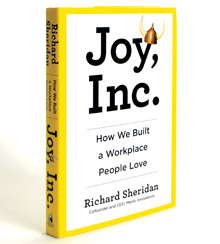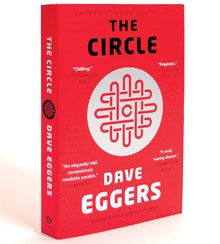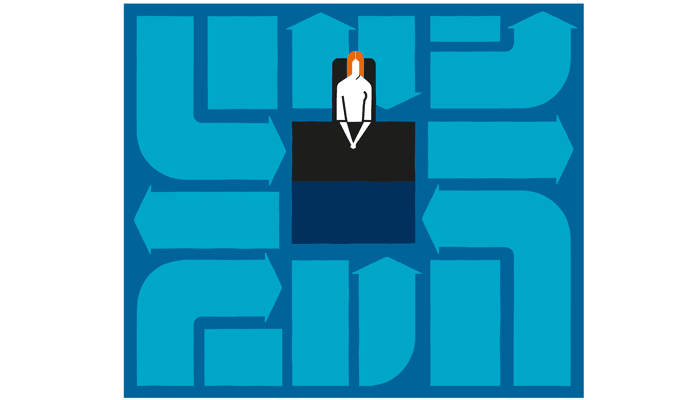Best Business Books 2014: Organizational Culture
The Nothing That’s Everything
Richard Sheridan
Joy, Inc.: How We Built a Workplace People Love
(Portfolio/Penguin, 2013)
Malachi O’Connor and Barry Dornfeld
The Moment You Can’t Ignore: When Big Trouble Leads to a Great Future
(PublicAffairs, 2014)
Dave Eggers
The Circle
(Knopf, 2013)
Increasingly, business consultants, scholars, and executives are coming to the conclusion that culture is the prime driver of organizational performance. Despite the prevalence of that point of view, however, there’s little agreement about what culture is or what it entails. You can’t see it, touch it, or measure it, yet culture is said to explain why some companies fare better than others. The authors of the year’s three best business books on culture, one of which is a novel, explore the elusive subject from widely divergent perspectives, but all end up confirming that it is the single most powerful influence on how people behave in organizations.
A Leader’s Insights
In Joy, Inc.: How We Built a Workplace People Love, Richard Sheridan, cofounder and CEO of software design firm Menlo Innovations, delineates the practical steps he has taken to create and maintain a corporate culture that makes people “excited to come to work every day.” The book provides a detailed look at how a culture is intentionally designed and implemented right from a company’s start.
Although Sheridan shies away from defining the term culture, he uses it as a shorthand way of encapsulating the unique personality of his company, which is, in his reckoning, a highly productive organization where a “culture of joy” entices workers to enthusiastically engage, without being coerced or controlled by management. He says that Menloians willingly give their all at work because of the intrinsic rewards they derive from constantly learning new things and being granted a high degree of autonomy in how they manage their work. I think I believe him, even though the “joy” part seems like a hyperbolic stretch.
The practical aspects of Menlo’s culture that Sheridan describes will be useful to any manager who wants to bolster employee engagement. He offers a raft of suggestions about how to transform work into a self-managed learning experience, and how to encourage constant dialogue and discussion among all employees in the firm—including the shiest and most introverted—in order to share that learning across the company.
Many of these ideas are creative, some are tried and true, and almost all are deserving of consideration. The most innovative—even radical—of Menlo’s practices is the pairing of employees (in the main, software programmers): “Two people sit together at one computer working all day on the same task at the same time,” explains Sheridan. These pairings are rotated weekly, so eventually every employee at this midsized firm works intimately with every other one. Sheridan makes a strong case that this seemingly expensive and inefficient practice actually increases organizational productivity, learning, innovation, and quality, while reducing stress and fatigue.
Other ideas include having the paired employees describe their projects to the entire workforce at “Lunch ’n Learn” sessions, putting clients on Menlo teams, replacing rules and bureaucracy with rituals and storytelling, and holding daily “stand-up meetings” in which all team members quickly describe “what they are working on and where they might need help.” (It is interesting that this high-tech company makes extensive use of low-tech tools, such as pencil-and-paper storyboards, to keep track of projects and clarify responsibilities.) Certain programs and policies are also aimed at making Menloians feel that they are members of a supportive community. For example, new parents can bring their babies to the office, where fellow workers are said to bounce crying infants when their moms and dads are busy at work tasks.
One thing that is noticeably missing from Sheridan’s otherwise detailed portrait of the company’s culture is a discussion of compensation. Unlike other high-involvement organizations, Menlo seems not to make use of profit sharing, stock ownership, gain sharing, and other proven methods for rewarding the people who do the work that leads to financial success. Only at the end of the book does Sheridan express the aspirational hope that by 2018, his employees will “trade up to 50 percent of their own income for the upside on the project they are working on.”
After 13 years in business—and several years of Sheridan trumpeting his approach at management conferences—it seems odd that “hope” is the best Menlo can do in this regard. Convinced as I am of the value of the company’s admirable managerial practices, this sows seeds of doubt in my mind about the real purpose of a culture of joy. Is it just a creative way of getting employees to work harder without fully compensating them for their efforts? I hope that Sheridan doesn’t wait another three years before cutting Menloians in on the action, but for now, we can content ourselves with studying his culture-building prowess.
An Anthropological View
Culture has long been the purview of anthropologists, but oddly, there are no previously published books that I can think of that offer an anthropological perspective on corporate culture and change. Into the breach step Malachi O’Connor and Barry Dornfeld, anthropologists with University of Pennsylvania Ph.D.s in folklore and communication, respectively, who turned their attention to management consulting, and more specifically to the study of corporate culture. In their manager-oriented manual, The Moment You Can’t Ignore: When Big Trouble Leads to a Great Future, they ably explain “how culture drives strategic change.”
The anthropological perspective on culture and change is long overdue because, as the authors note, “behavior is culturally prescribed.” Thus, they address the issue of changing a company culture at its root level: the behavior of its employees. Starting from the familiar premise, attributed to Peter Drucker, that “culture eats strategy for breakfast,” O’Connor and Dornfeld offer useful advice on how to deal with the human side of strategy implementation: getting employees to accept needed change.
In 1881, British anthropologist E.B. Tylor defined culture like this: “that complex whole which includes knowledge, belief, art, morals, law, custom, and any other capabilities and habits acquired…as a member of [a] society.” Other researchers later added the idea that cultures are social systems, the numerous parts of which are complexly interrelated. Over many decades, social anthropologists would draw several conclusions about tribal and national cultures: They are all different; they are not consciously designed, but instead grow organically as the result of such influences as the local environment, available technology, and the long process of trial and error called human experience; and they are far easier to destroy than to consciously build.
The concept of organizational or corporate culture is of more recent origin. (Warren Bennis and I could find no published references to the concept when we first discussed it at a gathering of social scientists at the Aspen Institute in 1973.) As the study of organizational culture has developed, however, it is clear that the insights of pioneering anthropologists about societies are broadly applicable to modern business organizations. Every company has a culture, and each one is unique, difficult to accurately describe or model, and hard to change. Additionally, most organizational cultures are complexly interrelated systems that initially tend to reflect the beliefs and values of their founders, which are, in turn, influenced by such factors as local customs and norms, the type of industry, and the technology employed.
Because the process of cultural genesis is largely unplanned, to later alter any major part of a system (the authors focus on strategy) requires modifying other parts to ensure compatibility and, thus, the effective functioning of the whole. That means, in effect, that Richard Sheridan’s shaping of Menlo’s culture from scratch was far easier than the task faced by leaders of established companies when they attempt to change existing cultures. O’Connor and Dornfeld usefully focus on the latter task.
Changing an existing culture, particularly in a large organization, is so hard because it’s analytically difficult to pinpoint precisely how any one part of a system interacts with any other part. Further, some parts can be devilishly hard to detect. For instance, the actual values of an organization are often hidden from view; therefore, it’s challenging to identify and measure them (even if the organization posts a list of “Our Values” on the lunchroom wall). Nonetheless, because people typically act in ways aimed at achieving what they value, it is possible to infer the true values of an organization by observing the behavior of its members. In practice, then, cultural change can be the most daunting of all social tasks, because it goes against what an organization’s members value. That’s why O’Connor and Dornfeld’s behavioral perspective is of practical use.
As difficult as a functioning culture is to identify, define, and change, it is the sine qua non of organizational performance, a fact Louis Gerstner discovered when he became CEO of then-troubled IBM in the early 1990s. Previously, Gerstner had earned a reputation for being a quantitatively oriented top executive, and he took on IBM’s turnaround believing that his rigorous management-by-the-numbers approach would be sufficient to get the job done. However—as Gerstner explained in his account of his tenure at IBM, Who Says Elephants Can’t Dance? Inside IBM’s Historic Turnaround (HarperBusiness, 2002)—he came to see that “culture isn’t just one aspect of the game—it is the game.” He described how the reshaping of IBM’s culture became his prime leadership task. The method he used can be rendered in the words of O’Connor and Dornfeld: “Leaders can no longer push for results but must create pull for achieving them by mobilizing the passion, interests, and energy of others.”
Creating that pull is a tall order, which is made even more challenging by the paradoxical nature of cultures: They become dysfunctional if they are too weak, and equally dysfunctional if too strong. Weak cultures encourage members of an organization to do their own thing, which leads to a lack of focus, coordination, and effectiveness. Because there is no unifying, collective purpose, there is insufficient motivation and commitment. In contrast, as O’Connor and Dornfeld point out, strong cultures tend to become rigid, complacent, and susceptible to groupthink. Because members who dare to question fundamental organizational assumptions are viewed as disloyal, a shortage of healthy self-criticism develops, which leads to resistance to change and innovation. And, as we see below, a too-powerful culture can even take an unethical turn.
The Novelist’s Take
High-tech company the Circle is the brainchild of novelist Dave Eggers and the setting for his best-selling novel of the same name. The events in The Circle occur in the future, but just barely so: Even geezers like me might live to see the day Eggers describes. The genius of the book—and what separates it from run-of-the-mill science fiction—is that Eggers extends Silicon Valley’s existing technology and organizational practices no further than to their next logical steps (imagine Google on steroids), and only at the conclusion does he move to the illogical and chilling end to which they may be heading.
Most reviews of The Circle have focused on the frightening prospect of the loss of freedom, democracy, and ethical judgment inherent in the privacy-invading technology emerging in Silicon Valley, but there have been fewer comments about the equally terrifying corporate culture that Eggers realistically limns.
If the Circle were a real company, it would sit atop Fortune’s list of the 100 Best Companies to Work For with its platinum medical insurance, free gourmet lunches, health club, laundry service, pet sitting, luxury commuter buses, and the Menlo-like opportunity to be creative and learn on company time. The purpose of these perks is, of course, to encourage employees to spend more time working productively, and less time managing their personal lives, wasting time with friends and family, and, presumably, reading long novels like The Circle. But the fictional company doesn’t stop there. It elevates these goodies to the next level, satisfying not only employee needs, but also their wants, with first-class live entertainment, boozy parties, on-campus housing (with opportunities for sex), social clubs, a sense of community and social purpose, and even, dare I say, a dollop of joy.
Almost everything the Circle does is, on its face, positive for employees, customers, and society. Thus, the novel’s protagonist, Mae Holland, initially finds the company campus and her new job exhilarating: “The company had so much going on, so much humanity and good feeling, and was pioneering on all fronts.” When she discovers her father is suffering from a life-threatening disease not covered by his health insurance, the Circle generously adds him to Mae’s company plan. The catch, naturally, is that Mae becomes locked into the company, in effect signing a social contract in which she gets all, in exchange for giving all—ultimately giving up her freedom, humanity, and individualism. Over the novel’s fast-paced 491 pages, Mae is gradually transformed from a loving, idealistic young woman into an unquestioningly loyal “true believer” willing to betray friends and lovers in order to advance the Circle’s goal of taming “the chaos of an orderless world.”
As in Plato’s Republic, creating such a well-ordered organization ultimately requires its members to abandon their freedom to Guardians who “know better than they do” what is good for them, because, as the Circlers assert, “We are the future.” In the end, the Circle develops a culture of arrogance in which those who disagree with the brave new world that it is bent on creating are dismissed as being on “the wrong side of history.”
Eggers’s characters are recognizable as people we know, and those we know about by reputation. Mae is Everywoman, typifying today’s inexperienced, overqualified young college grad desperate to find a good job in a bad labor market. Her relatively uneducated, craftsman ex-boyfriend is the voice of reason. He tells Mae, “Like everything else you guys are pushing, it sounds perfect, sounds progressive, but it carries with it more control, more central tracking of everything we do.” (Mae, in perfect character, dismisses the warning as “antiquarian bullshit.”) And the troika who founded the Circle are three variations on the charismatic, visionary, self-confident, brilliant, and obsessively single-minded leaders found in abundance in the tech world.
Yet the novel is not an antitechnology, antibusiness diatribe. It is a premonitory tale about the potential consequences of well-intentioned corporate cultures run amok. Eggers calls attention to the fine line between the compellingly powerful cultures found at places like Menlo Innovations, on the one hand, and the 21st-century equivalent of the corporate paternalism that spawned company towns and captive workforces a century or so ago, on the other. Although fictional, The Circle is the best business book of the year about corporate culture because it raises ethical and philosophical questions that are not, and cannot safely be, raised in many companies—and not just high-tech ones.
Jim O’Toole picks Dave Eggers’ novel, The Circle, as the best business book on organizational culture this year.
Reprint No. 00290
Author profile:
- James O’Toole is a longtime contributing editor to s+b and a senior fellow in business ethics at Santa Clara University’s Markkula Center for Applied Ethics. He is the author of 17 books, including Leading Change: The Argument for Values-Based Leadership (Ballantine Books, 1996).







